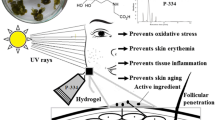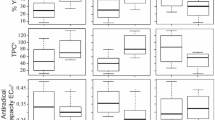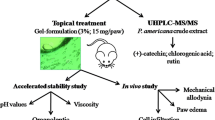Abstract
In this study, lyophilized crude and methanolic extracts of aloe gel from different germplasms (S24, RM, TN, OR, and RJN) of Aloe vera L. were tested for their ultraviolet (UV) opacity potential. UV absorption profiles, sun protection factor (SPF), and percentage blocking of UVA and UVB were considered to test UV opacity potential. Both the extracts showed UV absorption and followed the same path in the wavelength range of 250–400 nm in all the germplasms. Methanolic extract showed a stronger absorptivity than the crude lyophilized extract. Among the tested germplasms, maximum UV opacity property with a SPF of 9.97% and 79.12% UVB blocking was obtained with RJN, whereas a poor response was evident in TN with a SPF of 1.37% and 28.5% UVB blocking at 4 mg/ml methanolic extract. To our knowledge the present work for the first time documents UV opacity properties of A. vera L. gel and opens up new vistas in Aloe gel characterization.
Similar content being viewed by others
Explore related subjects
Discover the latest articles, news and stories from top researchers in related subjects.Avoid common mistakes on your manuscript.
Introduction
Exposure of human skins to ultraviolet (UV) radiation is increasing because of depletion of the stratospheric ozone layer. Chronic exposure to UV may cause sunburn, skin cancer, oxidative stress as well as photoaging [1–4]. Numerous epidemiological investigations show that protection from solar UV radiation will reduce the risk of acute and chronic skin damage in humans. There has been increasing interest in protection against solar UV radiation using various types of sunscreen. UV opacity is the property of sunscreens which absorb and/or block UV radiations from reaching the skin. The biological activity of a sunscreen is evaluated by its ability to protect human skin from erythema and is represented by a sun protection factor (SPF) [5, 6]. The SPF provides an index of protection against erythemally effective solar UV, largely confined to the UVB (290–320 nm) and short-wavelength UVA (320–340 nm) region [7]. In order to avoid expensive and time-consuming in vivo UV protection testing, in vitro method for SPF measurement using spectral transmission has been developed. [5]. The spectral transmittance of a sunscreen in the ultraviolet spectral range can be used to predict an in vitro SPF value based on standard erythema and solar data [5, 6].
Aloe vera L. (syn. A. barbadensis Miller) belonging to the family Liliaceae has been known traditionally as the “healing plant” and used in a variety of cosmetic product formulations. The mucilaginous gel of this plant has been shown to have wound healing [8], anti-inflammation [9], immunostimulatory [10, 11], and antioxidant properties [12]. However, in spite of its use as an ingredient in myriad health and cosmetic products the UV opacity potential of aloe gel has not yet been demonstrated. Plant extracts have recently been considered as a potential source of sunscreens due to their absorption in UV regions as well as antioxidant properties [13, 14]. Root extract of Pothomorphe umbellata and extracts from lichens and boldo tree were found to have antioxidant and photostability properties [15, 16]. The protection factors as well as the good UV light absorption of their photoproducts suggest the use of natural substances in sunscreen preparations.
The goals of the present work are to evaluate the UV absorption potential and to determine the in vitro sun protection factor of aloe gel obtained from different germplasms of A. vera L.
Materials and methods
Plant materials
Germplasms of A. vera L. (A. barbadensis Miller) were collected from different agroclimatic zones of India. The plant material was identified by Prof. G. G. Maity, Taxonomist, University of Kalyani and was grown in the Agricultural and Food Engineering Departmental farm of IIT Kharagpur, India. The five studied germplasms are designated S24, RM, TN, OR, and RJN.
Extract preparation
Healthy and fresh leaves having a length of 30–45 cm were collected from 10- to 12-month-old plants and were washed with distilled water to remove dirt. After removing the spikes, the leaves were cut transversely into pieces and the thick epidermis was carefully separated from the parenchyma using a scalpel-shaped knife. The resulting mucilaginous gel was homogenized and freeze-dried with a yield of 2.5, 2.1, 0.9, 1.8, and 1.5 g, respectively, for the germplasms S24, RM, TN, OR and RJN. To obtain methanolic extracts, 1 g of lyophilized gel was mechanically agitated in 80 ml 80% methanol for 4 h. The mixture was then centrifuged at 10,000 rpm for 15 min. The supernatant was evaporated under reduced pressure at 40°C to obtain the sticky brown methanolic extracts (300, 232, 104, 240, and 206 mg, respectively, for the germplasms S24, RM, TN, OR, and RJN). Test samples were obtained by dissolving lyophilized crude and methanolic extracts in phosphate buffer saline (PBS, pH 7.4).
UV opacity analysis and determination of in vitro sun protection factor
The spectral properties of aloe gel were tested initially with the germplasm S24 at 1, 2, and 4 mg/ml concentrations and were measured using UV–VIS–NIR spectrophotometer (Perkin-Elmer, USA, Model Lamda-900) for the wavelength range 280–400 nm (UV-A, 320–400 nm; UV-B, 280–320 nm). Among the tested concentrations, 4 mg/ml was found to be more opaque and was used for analysis in other germplasms. The samples were taken in high-quality quartz cuvette of thickness 2 mm for this measurement. Absorption coefficient (α) values were obtained for each wavelength by using α = −ln(T/100)/path-length. SPF was calculated from the percentage transmission T obtained at UV wavelengths from 280 to 400 nm using the following equation [5]:
where E λ is the International Commission on Illumination (CIE) erythemal spectral effectiveness, S λ is the spectral irradiance, and T λ is the spectral transmittance of the sample. The erythemally weighed UV intensity (E λ S λ ) values for each wavelength (280–400 nm) were obtained from the combined solar/erythemal response plot as shown in Springsteen et al. [5]. The percentage UV-A and UV-B blocking values were calculated as described by Springsteen et al. [5]. The average transmittance in UV-A (315–400 nm) and UV-B (280–315 nm) regions was obtained, and consequently the percentage blocking for UV-A and UV-B were determined. All data are means of three replicated determinations.
Results and discussion
Aloe gel extracts exhibits UV opacity as revealed by percentage transmittance and absorption coefficient in a dose-dependent manner. The coefficient values represent a more reliable presentation of the thickness-independent absorption properties of the gel samples. Among the tested concentrations, 4 mg/ml showed the maximum UV opacity both in lyophilized crude and methanolic extracts (Figs. 1 and 2). Thus this concentration was used to compare the UV opacity potential of various aloe germplasms. UV absorption profiles of various germplasms along with percentage transmittance are presented in Figs. 3 and 4. In all the germplasms UV absorption increased linearly from 400 to 320 nm, which corresponds to the UVA–UVB range. A peak was observed in the 280–320 nm range. A sharp fall in absorbance was observed in the UVC range. These findings suggest a strong UV absorption potential of aloe gel extracts in both the UVA and UVB ranges. Aqueous and alcoholic extracts of black tea also revealed a similar trend in UV absorption profile [17]. However, UVB blocking was more pronounced than UVA. In contrast, para-aminobenzoic acid (PABA), a known sunscreen component, shows only UVB blocking (Fig. 5).
SPF values determined for each germplasm are presented in Fig. 6. The SPF ranged from 1.29 to 3.49 and 1.37 to 9.97 for crude lyophilized and methanolic extracts, respectively. There is a concern about using SPF as it is based on erythema, which incorporates UVB wavelength regions. For a sunscreen, it is also important to have UVA protection. To assess the level of UV protection, we determined the percentage blocking of UVB as well as UVA. Figure 7 summarizes the percentage blocking of UVA and UVB of Aloe germplasms. Maximum UVA blocking of 79.12% and UVB blocking of 91.07% was observed in methanolic extracts of RJN. The reference PABA documents SPF of 1.46% and 68.04% UVB blocking at 1 mM concentration. The SPF and UV blocking ability of lyophilized samples followed the trend RJN > S24 > RM > OR > TN, whereas the trend in methanolic extracts noted was RJN > RM > OR > S24 > TN.
Of the tested germplasms, the filtering potential of erythema-causing wavelengths was evidently maximum with RJN and minimum with TN. Compared with lyophilized crude gel, methanolic extract showed higher UV opacity properties, following a similar trend in absorption profiles. This could be due to greater solubility and increased concentrations of gel components in methanolic extract. The use of crude and simple extraction procedures without chromatographic separation of components was found to be an easy approach to screen germplasms with high UV opacity potential. To our knowledge, the present report for the first time describes the UV opacity potential of aloe gel. The variations in UV opacity potential among the germplasms may be due to the presence of different degrees of bioactive components present in Aloe gel. Secondary metabolites such as flavonoids and sinapate esters in the plant leaves can absorb in the UV range in methanolic extracts [18, 19]. Presumably, polyphenols in Aloe extracts were the main UV absorbing elements. It has been believed that Aloe gel has a modulating effect on the skin by preventing UVB sun rays from sensitizing the skin, especially in the first 24 h following exposure [20]. UV light-filtering power of aloe gel in vivo remains to be investigated.
References
Stolarski R, Bojkov R, Bishop L, Zerefos C, Staeheln J, Zawodny J (1992) Measured trends in stratospheric ozone. Science 256:342–349
Ichihashi M, Ueda M, Budiyanti A, Bito T, Oka M, Fukunaga M, Tsuru K, Horikawa T (2003) UV-induced skin damage. Toxicology 189:21–39
Melnikova VO, Ananthaswamy HN (2005) Cellular and molecular events leading to the development of skin cancer. Mutat Res 571:91–106
Reichrath J (2006) The challenge resulting from positive and negative effects of sunlight: How much solar UV exposure is appropriate to balance between risks of vitamin D efficiency and skin cancer? Prog Biophys Mol Biol 92:9–16
Springsteen A, Yurek R, Frazier M, Carr KF (1999) In vitro measurement of sun protection factor of sunscreens by diffuse transmittance. Anal Chim Acta 380:155–164
Toyoshima M, Hosoda K, Hanamura M, Okamoto K, Kobayashi H, Negishi T (2004) Alternative methods to evaluate the protective ability of sunscreen against photo genotoxicity. J Photochem Photobiol B Biol 73:59–66
Bernard F, Vioux C, Lejuene F, Asselinease D (2003) The sun protection factor (SPF) inadequately defines broad spectrum photoprotection: demonstration using skin reconstructed in vitro exposed to UVA, UVB or UV-solar simulated radiation. Eur J Dermatol 13:242–249
Davies RH, Leitner MG, Russo JM, Byrne ME (1989) Wound healing. Oral and topical activity of Aloe vera. J Am Podiatr Med Assoc 79:559–562
Davies RH, Stewart GI, Bregman PJ (1992) Aloe vera and the inflamed synovial pouch model. J Am Podiatr Med Assoc 82:140–148
Strickland FM, Pelly RP, Kripke ML (1994) Prevention of ultraviolet radiation-induced suppression of contact and delayed hypersensitivity of Aloe barbadensis gel extract. J Invest Dermatol 102:197–204
Nia Y, Turner D, Yatesa KM, Tizard I (2004) Isolation and characterization of structural components of Aloe vera L. leaf pulp. Int Immunopharmacol 4:1745–1755
Hu Y, Xu J, Hu Q (2003) Evaluation of antioxidant potential of Aloe vera (Aloe barbadensis miller) extracts. J Agric Food Chem 51:7788–7791
Liu MC, Lin CT, Shau MD, Chen ZS, Chen MJ (1996) Studies on natural ultraviolet absorbers. J Food Drug Anal 4:243–248
Bonina F, Lanza M, Montenegro L, Puglisi C, Tomaino A, Trombetta D, Castelli F, Saija A (1996) Flavonoids as potential protective agents against photo-oxidative skin damage. Int J Phar 145:87–94
Rancana F, Rosana S, Boehmb K, Fernandezc E, Hidalgoc E, Quihotc W, Rubioc C, Boehmb F, Piazenaa H, Oltmanns U (2002) Protection against UVB irradiation by natural filters extracted from lichens. J Photochem Photobiol B Biol 68:133–139
Silva VV, Ropke CD, Almeida RL, Miranda DV, Kera CZ, Rivelli DP, Sawada ACH, Barros BSM (2005) Chemical stability and SPF determination of Pothomorphe umbellata extract gel and photostability of 4-nerolidylcathecol. Int J Pharm 303:125–131
Turkoglu M, Cigirgil N (2007) Evaluation of black tea gel and its protection potential against UV. Int J Cosmet Sci 29:437–442
Strid A, Porra RJ (1992) Alterations in pigment content in leaves of Pisum sativum after exposure to supplementary UV-B. Plant Cell Physiol 33:1015–1023
Landry LG, Chapple CCS, Last RL (1995) Arabidopsis mutants lacking phenolic sunscreens exhibit enhanced ultraviolet-B injury and oxidative damage. Plant Physiol 109:1159–1166
Jennings WM, Wilkinson JM, Shillington D (2005) Novel approaches to radiotherapy-induced skin reactions: a literature review. Complement Therap Clin Prac 11:224–231
Acknowledgments
The work was supported by grants from the Department of Science and Technology, New Delhi, India.
Author information
Authors and Affiliations
Corresponding author
Rights and permissions
About this article
Cite this article
Kumar, M.S., Datta, P.K. & Dutta Gupta, S. In vitro evaluation of UV opacity potential of Aloe vera L. gel from different germplasms. J Nat Med 63, 195–199 (2009). https://doi.org/10.1007/s11418-008-0299-z
Received:
Accepted:
Published:
Issue Date:
DOI: https://doi.org/10.1007/s11418-008-0299-z











